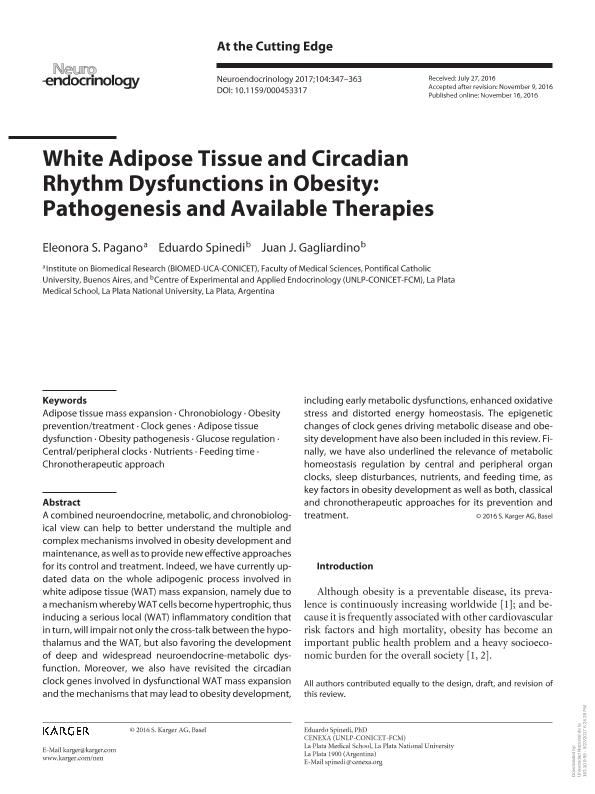Mostrar el registro sencillo del ítem
dc.contributor.author
Pagano, Eleonora Samanta

dc.contributor.author
Spinedi, Eduardo Julio

dc.contributor.author
Gagliardino, Juan Jose

dc.date.available
2018-06-07T18:29:55Z
dc.date.issued
2017-04
dc.identifier.citation
Pagano, Eleonora Samanta; Spinedi, Eduardo Julio; Gagliardino, Juan Jose; White Adipose Tissue and Circadian Rhythm Dysfunctions in Obesity: Pathogenesis and Available Therapies; Karger; Neuroendocrinology; 104; 4; 4-2017; 347-363
dc.identifier.issn
0028-3835
dc.identifier.uri
http://hdl.handle.net/11336/47725
dc.description.abstract
A combined neuroendocrine, metabolic, and chronobiological view can help to better understand the multiple and complex mechanisms involved in obesity development and maintenance, as well as to provide new effective approaches for its control and treatment. Indeed, we have currently updated data on the whole adipogenic process involved in white adipose tissue (WAT) mass expansion, namely due to a mechanism whereby WAT cells become hypertrophic, thus inducing a serious local (WAT) inflammatory condition that in turn, will impair not only the cross-talk between the hypothalamus and the WAT, but also favoring the development of deep and widespread neuroendocrine-metabolic dysfunction. Moreover, we also have revisited the circadian clock genes involved in dysfunctional WAT mass expansion and the mechanisms that may lead to obesity development, including early metabolic dysfunctions, enhanced oxidative stress and distorted energy homeostasis. The epigenetic changes of clock genes driving metabolic disease and obesity development have also been included in this review. Finally, we have also underlined the relevance of metabolic homeostasis regulation by central and peripheral organ clocks, sleep disturbances, nutrients, and feeding time, as key factors in obesity development as well as both, classical and chronotherapeutic approaches for its prevention and treatment.
dc.format
application/pdf
dc.language.iso
eng
dc.publisher
Karger

dc.rights
info:eu-repo/semantics/openAccess
dc.rights.uri
https://creativecommons.org/licenses/by-nc-sa/2.5/ar/
dc.subject
ADIPOSE TISSUE DYSFUNCTION
dc.subject
ADIPOSE TISSUE MASS EXPANSION
dc.subject
CENTRAL/PERIPHERAL CLOCKS
dc.subject
CHRONOBIOLOGY
dc.subject
CHRONOTHERAPEUTIC APPROACH
dc.subject
CLOCK GENES
dc.subject
FEEDING TIME
dc.subject
GLUCOSE REGULATION
dc.subject
NUTRIENTS
dc.subject
OBESITY PATHOGENESIS
dc.subject
OBESITY PREVENTION/TREATMENT
dc.subject.classification
Medicina Critica y de Emergencia

dc.subject.classification
Medicina Clínica

dc.subject.classification
CIENCIAS MÉDICAS Y DE LA SALUD

dc.title
White Adipose Tissue and Circadian Rhythm Dysfunctions in Obesity: Pathogenesis and Available Therapies
dc.type
info:eu-repo/semantics/article
dc.type
info:ar-repo/semantics/artículo
dc.type
info:eu-repo/semantics/publishedVersion
dc.date.updated
2018-06-07T16:14:24Z
dc.journal.volume
104
dc.journal.number
4
dc.journal.pagination
347-363
dc.journal.pais
Suiza

dc.journal.ciudad
Basilea
dc.description.fil
Fil: Pagano, Eleonora Samanta. Pontificia Universidad Católica Argentina "Santa María de los Buenos Aires". Instituto de Investigaciones Biomédicas. Consejo Nacional de Investigaciones Científicas y Técnicas. Oficina de Coordinación Administrativa Houssay. Instituto de Investigaciones Biomédicas; Argentina
dc.description.fil
Fil: Spinedi, Eduardo Julio. Consejo Nacional de Investigaciones Científicas y Técnicas. Centro Científico Tecnológico Conicet - la Plata. Centro de Endocrinología Experimental y Aplicada. Universidad Nacional de la Plata. Facultad de Cs.médicas. Centro de Endocrinología Experimental y Aplicada; Argentina
dc.description.fil
Fil: Gagliardino, Juan Jose. Consejo Nacional de Investigaciones Científicas y Técnicas. Centro Científico Tecnológico Conicet - la Plata. Centro de Endocrinología Experimental y Aplicada. Universidad Nacional de la Plata. Facultad de Cs.médicas. Centro de Endocrinología Experimental y Aplicada; Argentina
dc.journal.title
Neuroendocrinology

dc.relation.alternativeid
info:eu-repo/semantics/altIdentifier/doi/https://dx.doi.org/10.1159/000453317
dc.relation.alternativeid
info:eu-repo/semantics/altIdentifier/url/https://www.karger.com/Article/FullText/453317
Archivos asociados
